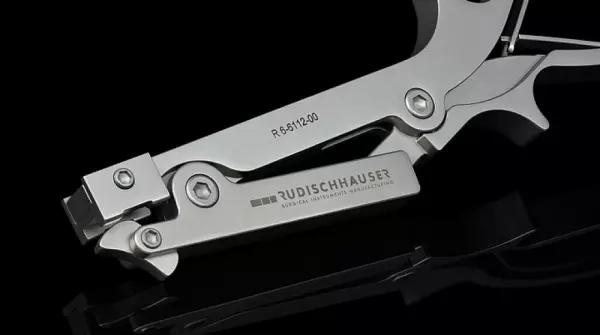
Spine - Instruments & Implants
We develop, optimise and manufacture a variety of spinal implants and instruments (e.g. pedicle scre...
Portal and digital medical technology fair of the largest MedTech cluster in Germany

Spine - Instruments & Implants
We develop, optimise and manufacture a variety of spinal implants and instruments (e.g. pedicle scre...

Sliding shaft instruments have a sliding part which can be moved along the axis of the instrument. A distal guide groove and a distal end are located at the proximal end of the sliding part 14. The sliding part and the shaft are in contact with one another on the sliding plane 28. The locking slide engages in the proximal end of the guide groove. When the locking slide is engaged, the instrument slides out of its working position.
The instrument comprises a gripping part with a rear gripping element arranged at an angle on the end of the guide element. The sliding part is supported by the guide on a pivot. A carrier element is disposed in the front of the gripping portion to carry the coupling component. The rear gripping mechanism is secured by a securing device (15) arranged in a form closure component (14), which engages with a guide groove's proximal end.
The sliding shaft instrument includes a dismantling mechanism to prevent accidental dismantling. The sliding part has a safety position to limit the opening angle of the grip elements. When the grip elements are fully opened, the profile web does not engage the mounting opening. The instrument can be easily removed and cleaned after use. Sliding shaft instruments are designed to be easy to operate and maintain, and a quick, painless and easy process makes them a convenient choice for the average surgical patient.
The sliding part of a sliding shaft instrument is either separated from the remaining instrument or connected to it. This can prevent accidental slipping of the instrument. Examples of such sliding shaft instruments include Tontarra for a Surgical Instrument issued to a U.S. patent application on Dec. 7, 2005. The proximal end of the slide part is connected to a pivotable handle portion on the proximal end. The sliding part may also be attached to a distal end of the instrument by means of a splint.
The distal part of a sliding shaft instrument is often connected to the rest of the instrument. The sliding part is connected to the shaft by a hinged hinge on its proximal end. The locking pin is in a locking position, and the sliding part is secured axially on the shaft. By compressing or expanding the handle parts, the instrument can be displaced axially on the shaft. A distal end of a sliding shaft has an additional locking pin that prevents accidental lateral displacement of the sliding part on the shaft.
Sliding shaft instruments are a common type of instrument. They are commonly used in dental surgery. They are typically equipped with a pivotable handle part and a stationary handle. The sliding part is guided on the shaft by a rotating part. During a procedure, the sliding shaft is positioned on the distal end of the instrument. The distal end of the instrument has working elements arranged thereon. The cutting edges are guided by axial movements of the sliding part.
Become a digital exhibitor yourself in the online portal of the largest and best-known MedTech cluster region in Germany and inform the world of medical technology about your products and services as well as about news, events and career opportunities.
With an attractive online profile, we will help you to present yourself professionally on our portal as well as on Google and on social media.